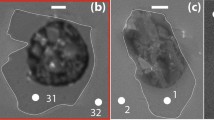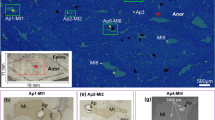Abstract
Trace-element partitioning between gregoryite, nyerereite, and natrocarbonatite melt is primordial for understanding trace-element distribution and fractionation in alkali-rich carbonatites. However, trace-element data are scarce for gregoryite and nyerereite. Here, we provide the first partition coefficients and lattice strain model parameters for trace-element partitioning between these carbonate minerals and natrocarbonatite at Oldoinyo Lengai (Tanzania). Nyerereite and gregoryite phenocrysts crystallize within a shallow magmatic reservoir (< 3 km depth, ~ 600 °C), and gregoryite continues to crystallize during magma ascent at lower pressures. At these low-temperature and pressure conditions, trace elements behave incompatibly in both gregoryite and nyerereite. Trace-element partitioning is characterized by a parabolic fit between the partition coefficients and ionic radii that is explained by a lattice strain model in which the site radius (r0) decreases with increasing charge from r01+ = 1.1 Å to r04+ = 0.75 Å. We observed different partition coefficients in gregoryite (Ggy) and nyerereite (Nye): those in nyerereite are greater than those in gregoryite for REEs (\({D}_{Nd}^{Nye}\)= 0.58 vs. \({D}_{Nd}^{Ggy}\) = 0.21; \({D}_{La}^{Nye}\) = 0.27 vs. \({D}_{La}^{Ggy}\) = 0.12), Sr (\({D}_{Sr}^{Nye}\)= 0.92 vs. \({D}_{Sr}^{Ggy}\) = 0.5), Ba (\({D}_{Ba}^{Nye}\)= 0.22 vs. \({D}_{Ba}^{Ggy}\) = 0.1), and Rb (\({D}_{Rb}^{Nye}\)= 0.35 vs. \({D}_{Rb}^{Ggy}\) = 0.26), but lower for HFSEs (e.g., \({D}_{Hf}^{Nye}\) = 0.13 vs. \({D}_{Hf}^{Ggy}\) = 0.28; \({D}_{Nb}^{Nye}\) = 0.02 vs. \({D}_{Nb}^{Ggy}\) = 0.08). Because all trace elements are incompatible, their concentrations increase in the melt during differentiation and the crystallization of both gregoryite and nyerereite. Due to their different partition coefficients, we can constrain the shallow crustal crystallization history of natrocarbonatite melts at Oldoinyo Lengai: the crystallization of roughly equal proportions of gregoryite and nyerereite can produce aphyric natrocarbonatite compositions from a typical natrocarbonatite composition. The late-stage crystallization of gregoryite alone during magmatic ascent and eruption can significantly impact the concentrations of key elements, such as increasing LREE contents and LREE/HFSE and LILE/HFSE ratios in the residual melt. Our results also highlight that natrocarbonatite melt crystallization during the 2019 eruption proceeded at temperatures from 600 °C to as low as 300 °C.











Similar content being viewed by others
Data availability
All data from this study is already provided in the supplementary material.
References
Baudouin C, France L (2019) Trace element partitioning between wollastonite and alkaline silicate magmas. Chem Geol 523:88–94
Baudouin C, France L, Boulanger M, Dalou C, Devidal JL (2020) Trace element partitioning between clinopyroxene and alkaline magmas: parametrization and role of M1 site on HREE enrichment in clinopyroxenes. Contrib Mineral Petrol 175(5):1–15
Blundy J, Wood B (1994) Prediction of crystal–melt partition coefficients from elastic moduli. Nature 372(6505):452–454
Bolotina NB, Gavryushkin PN, Korsakov AV, Rashchenko SV, Seryotkin YV, Golovin AV, Litasov KD (2016) Incommensurately modulated twin structure of nyerereite Na1. 64K0. 36Ca (CO3) 2. Acta Crystallographica Sect B: Struct Sci, Crystal Eng Mat 73(2):276–284
Bosshard-Stadlin SA, Mattsson HB, Keller J (2014) Magma mixing and forced exsolution of CO2 during the explosive 2007–2008 eruption of Oldoinyo Lengai (Tanzania). J VolcanolGeotherm Res 285:229–246
Chebotarev DA, Veksler IV, Wohlgemuth-Ueberwasser C, Doroshkevich AG, Koch-Müller M (2019) Experimental study of trace element distribution between calcite, fluorite and carbonatitic melt in the system CaCO3+ CaF2+ Na2CO3±Ca3(PO4)2 at 100 MPa. Contrib Mineral Petrol 174:1–13
Chebotarev DA, Wohlgemuth-Ueberwasser C, Hou T (2022) Partitioning of REE between calcite and carbonatitic melt containing P S Si at 650–900° C and 100 MPa. Sci Rep 12(1):1–9
Chen W, Kamenetsky VS, Simonetti A (2013) Evidence for the alkaline nature of parental carbonatite melts at Oka complex in Canada. Nat Comm 4(1):1–6
Cooper AF (1975) The system Na2CO3-K2CO3-CaCO3 at 1 kilobar and its significance in carbonatite petrogenesis. Am J Sci 275(5):534–560
Dalou C, Boulon J, Koga KT, Dalou R, Dennen RL (2018) DOUBLE FIT: optimization procedure applied to lattice strain model. Comput Geosci 117:49–56
Dawson S, Smith DE, Ruffman A, Shi S (1996) The diatom biostratigraphy of tsunami sediments: examples from recent and middle Holocene events. Phys Chem Earth 21(1–2):87–92
Dawson JB, Smith JV, Steele IM (1995) Petrology and mineral chemistry of plutonic igneous xenoliths from the carbonatite volcano, Oldoinyo Lengai. Tanzania J Petrol 36(3):797–826
Griffin WL (2008) GLITTER: data reduction software for laser ablation ICP-MS. Laser Ablation ICP-MS in the Earth Sciences: Current practices and outstanding issues 308–311
Golubkova A, Merlini M, Schmidt MW (2015) Crystal structure, high-pressure, and high-temperature behavior of carbonates in the K2Mg (CO3)2–Na2Mg (CO3)2 join. Am Mineral 100(11–12):2458–2467
France L, Brouillet F, Lang S (2021) Early carbonatite magmatism at Oldoinyo Lengai volcano (Tanzania): carbonatite–silicate melt immiscibility in Lengai I melt inclusions. Comptes Rendus Géosci 353(S2):1–16
Keller J, Krafft M (1990) Effusive natrocarbonatite activity of Oldoinyo Lengai, June 1988. Bull Volcanol 52:629–645
Keller J, Spettel B (1995) The trace element composition and petrogenesis of natrocarbonatites. In Carbonatite Volcanism Springer, Berlin, Heidelberg
Keller J, Zaitsev AN (2012) Geochemistry and petrogenetic significance of natrocarbonatites at Oldoinyo Lengai, Tanzania: composition of lavas from 1988 to 2007. Lithos 148:45–53
Keller J, Klaudius J, Kervyn M, Ernst GG, Mattsson HB (2010) Fundamental changes in the activity of the natrocarbonatite volcano Oldoinyo Lengai. Tanzania Bull Volcanol 72(8):893–912
Kervyn M, Ernst GG, Klaudius J, Keller J, Kervyn F, Mattsson HB, Belton F, Mbede E, Jacobs P (2008) Voluminous lava flows at Oldoinyo Lengai in 2006: chronology of events and insights into the shallow magmatic system. Bull Volcanol 70(9):1069–1086
Klaudius J, Keller J (2006) Peralkaline silicate lavas at oldoinyo lengai. Tanzania Lithos 91(1–4):173–190
Krafft M, Keller J (1989) Temperature measurements in carbonatite lava lakes and flows from Oldoinyo Lengai. Tanzania Science 245(4914):168–170
Laxton K (2020) Collection of lava samples from Ol Doinyo Lengai. Nature Rev Earth Environ 1(9):438–438
Laxton K (2022) Natrocarbonatite volcanism at Ol Doinyo Lengai volcano, Tanzania: A multidisciplinary investigation of effusive activity following the 2007–2008 explosive eruption. Thesis publication, University College London
Mattsson HB, Caricchi L (2009) Experimental constraints on the crystallization of natrocarbonatitic lava flows. Bull Volcanol 71(10):1179–1193
McDonough WF, Sun SS (1995) Composition of the Earth. Chemgeol 120:223–253. https://doi.org/10.1016/0009-2541(94)00140-4
McKie D, Frankis EJ, (1977) Nyerereite: a new volcanic carbonate mineral from Oldoinyo Lengai Tanzania. Zeitschrift für Kristallographie-Crystalline Materials 145 (1) 73–95
Mitchell RH (2006) Mineralogy of stalactites formed by subaerial weathering of natrocarbonatite hornitos at Oldoinyo Lengai. Tanzania Mineral Magazine 70(4):437–444
Mitchell RH, Kamenetsky VS (2008) Trace element geochemistry of nyerereite and gregoryite phenocrysts from Oldoinyo Lengai natrocarbonatite lava. Geochim Cosmochim Acta Supplement 72(12):A637
Mitchell RH, Kamenetsky VS (2012) Trace element geochemistry of nyerereite and gregoryite phenocrysts from natrocarbonatite lava, Oldoinyo Lengai, Tanzania: Implications for magma mixing. Lithos 152:56–65
Mitchell RH, Kjarsgaard BA (2011) Experimental Studies of the System Na2CO3–CaCO3–MgF2 at 0.1 GPa: Implications for the Differentiation and Low-temperature Crystallization of Natrocarbonatite. J Petrol 52 (7–8): 1265–1280
Mollé V, Gaillard F, Nabyl Z, Tuduri J, Di Carlo I, Erdmann S (2021) Crystallisation sequence of a REE-rich carbonate melt: an experimental approach. Comptes Rendus Géoscience 353(S2):217–231
Mollex G, Füri E, Burnard P, Zimmermann L, Chazot G, Kazimoto EO, France L (2018) Tracing helium isotope compositions from mantle source to fumaroles at Oldoinyo Lengai volcano, Tanzania. Chem Geol 480:66–74
Perry E, Gysi AP (2020) Hydrothermal calcite-fluid REE partitioning experiments at 200 °C and saturated water vapor pressure. Geochim Cosmochim Acta 286:177–197
Peterson TD (1990) Petrology and genesis of natrocarbonatite. Contrib MineralPetrol 105:143–155
Petibon CM, Kjarsgaard BA, Jenner A, Jackson SE (1998) Phase relationships of a silicate-bearing natrocarbonatite from Oldoinyo Lengai at 20 and 100 MPa. J Petrol 39:2137–2151
Stoppa F, Jones AP, Sharygin VV (2009) Nyerereite from carbonatite rocks at Vulture volcano: implications for mantle metasomatism and petrogenesis of alkali carbonate melts Research Article. Central Europ J Geosci 1(2):131–151
Voigt M, Mavromatis V, Oelkers EH (2017) The experimental determination of REE partition coefficients in the water-calcite system. Chem Geol 462:30–43
Weidendorfer D, Schmidt MW, Mattsson HB (2017) A common origin of carbonatite magmas. Geology 45(6):507–510
Wood BJ, Blundy JD (1997) A predictive model for rare earth element partitioning between clinopyroxene and anhydrous silicate melt. Contrib Mineral Petrol 129(2):166–181
Yaxley GM, Anenburg M, Tappe S, Decree S, Guzmics T (2022) Carbonatites: classification, sources, evolution, and emplacement. Annu Rev Earth Planet Sci 50:261–293
Zaitsev AN, Keller J (2006) Mineralogical and chemical transformation of Oldoinyo Lengai natrocarbonatites. Tanzania Lithos 91(1–4):191–207
Zaitsev AN, Keller J, Spratt J, Jeffries TE, Sharygin VV (2009) Chemical composition of nyerereite and gregoryite from natrocarbonatites of Oldoinyo Lengai volcano. Tanzania Geology Ore Deposits 51(7):608–616
Acknowledgements
We thank M. Anenburg and an anonymous reviewer for their helpful and constructive comments, and also O. Müntener for efficient editorial handling and suggestions. We offer special thanks to Kate Laxton for providing samples and useful discussions. The authors would like to thank O. Rouer for help with microprobe measurements and C. Peiffert for assistance during LA-ICP-MS analyses. This work was supported by the French National Research Agency through the national program “Investissements d’avenir” with the reference ANR-10-LABX-21-01/LABEX RESSOURCES21, and through the project GECO-REE (ANR-16-CE01-0003-01; P.I., Lydéric France). This study was also supported by the Région Lorraine, and PNP and CESSUR programs from INSU-CNRS (grants to Lydéric France). This is CRPG contribution number 2846 and GECO-REE contribution number 7.
Author information
Authors and Affiliations
Corresponding author
Additional information
Communicated by Othmar Müntener.
Publisher's Note
Springer Nature remains neutral with regard to jurisdictional claims in published maps and institutional affiliations.
Supplementary Information
Below is the link to the electronic supplementary material.
Rights and permissions
Springer Nature or its licensor (e.g. a society or other partner) holds exclusive rights to this article under a publishing agreement with the author(s) or other rightsholder(s); author self-archiving of the accepted manuscript version of this article is solely governed by the terms of such publishing agreement and applicable law.
About this article
Cite this article
Baudouin, C., France, L. Trace-element partitioning between gregoryite, nyerereite, and natrocarbonatite melt: implications for natrocarbonatite evolution. Contrib Mineral Petrol 178, 40 (2023). https://doi.org/10.1007/s00410-023-02021-z
Received:
Accepted:
Published:
DOI: https://doi.org/10.1007/s00410-023-02021-z




